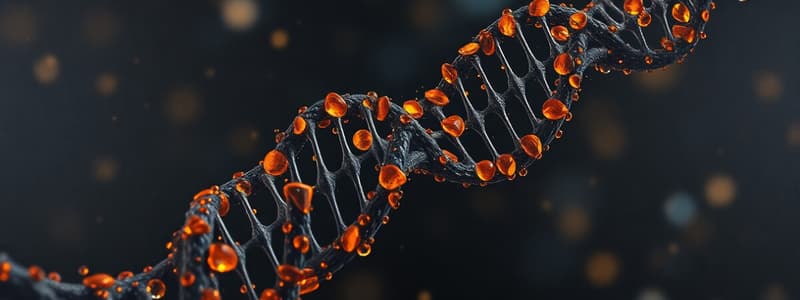Podcast
Questions and Answers
What process involves the conversion of ATP to ADP through the addition of a phosphate group?
What process involves the conversion of ATP to ADP through the addition of a phosphate group?
- Hydrolysis
- Phosphorylation (correct)
- Dephosphorylation
- Glycosylation
In the context of DNA, what is the primary molecule derived from adenine?
In the context of DNA, what is the primary molecule derived from adenine?
- Adenylic acid
- Adenosine (correct)
- Cyclic AMP
- Amplified adenine
Which of the following best describes the role of insulin in cell signaling?
Which of the following best describes the role of insulin in cell signaling?
- Activation of RNA polymerase
- Regulation of glucose uptake (correct)
- Promotion of lipid degradation
- Inhibition of protein synthesis
What type of bond is primarily involved in linking sugar molecules in a glycosidic linkage?
What type of bond is primarily involved in linking sugar molecules in a glycosidic linkage?
Which molecule is known to act as a secondary messenger in cellular signaling pathways?
Which molecule is known to act as a secondary messenger in cellular signaling pathways?
Flashcards
DNA structure
DNA structure
DNA is composed of nucleotides, linked together by ester bonds.
Phosphorylation
Phosphorylation
The addition of a phosphate group to a molecule.
Dephosphorylation
Dephosphorylation
The removal of a phosphate group from a molecule.
Adenosine
Adenosine
Signup and view all the flashcards
Glycosidic bond
Glycosidic bond
Signup and view all the flashcards
Study Notes
DNA and Molecular Biology
- DNA and RNA are nucleic acids.
- Nucleotides are the structural units of nucleic acids.
- Nucleotides are composed of a nitrogenous base, a pentose sugar, and a phosphate group.
- Nucleosides are composed of a nitrogenous base and a pentose sugar.
- Purines include adenine and guanine.
- Pyrimidines include cytosine, uracil, and thymine.
- Ribose is found in RNA
- Deoxyribose is found in DNA
- Uracil is found in RNA
- Thymine is found in DNA
- Cytosine is found in both DNA and RNA
Chemistry of Nucleotides
- A nucleotide is formed from a nitrogenous base, a pentose sugar, and a phosphate group.
- A nucleoside is formed from a nitrogenous base and a pentose sugar.
- The carbons of the pentose are named 1', 2', 3', 4', and 5'.
Nitrogenous Bases
- Major pyrimidines are uracil (RNA), thymine (DNA), and cytosine (both DNA and RNA).
- Minor pyrimidines include dihydro uracil and methyl cytosine.
- Major purines are adenine (DNA and RNA) and guanine (DNA and RNA).
Oxy Purines
- Hypoxanthine is not found in DNA or RNA
- Xanthine is formed during the synthesis or catabolism of major purines.
- Uric acid is the end-product of purine catabolism.
- Normal blood level is 3-7mg/dl. Elevated levels relate to gout (hyperuricemia).
- Methylated purines (Caffeine, Theophylline, Theobromine) are found in coffee, tea, and cocoa.
Nucleosides and Nucleotides
- Nucleosides are formed when a nitrogenous base is connected to a pentose sugar by an N-glycosidic bond.
- Nucleotides are formed when a phosphate group is attached to the 5' carbon of the pentose sugar.
- The naming of nucleosides and nucleotides is dependent on the nitrogenous base.
Free Nucleosides and Nucleotides
- Nucleotides and nucleosides are the building blocks of DNA and RNA.
- ATP, ADP, and AMP are examples of adenosine monophosphate, diphosphate and triphosphate.
- GMP, GDP, and GTP are examples of guanosine monophosphate, diphosphate and triphosphate,
- ATP is the body's energy currency.
- High-energy bonds link phosphate groups in ATP.
- ATP is used in mechanical, electrical, and chemical processes.
- Cyclic AMP (cAMP) and cyclic GMP (cGMP) are examples of secondary messengers.
Structure of Chromatin and Chromosomes
- Chromatin is DNA in non-dividing cells, not visible with light microscopes.
- Chromatin is visible in electron microscopes as a network of fibers.
- A chromosome is condensed DNA, formed before cell division, consisting of two identical chromatids.
- Chromosomes consist of one single DNA molecule and histone proteins.
- Histone proteins are basic and positively charged, attracting DNA (which has a negative charge).
- 5 types of histones are (H1, H2A, H2B, H3, H4).
- Nucleosomes are the basic repeating units of chromatin, consisting of a core of histone proteins with DNA wrapped around them.
- Linker DNA connects nucleosomes.
DNA Tertiary Structure
- Circular DNA occurs in mitochondria, chloroplasts and bacteria.
- DNA is mainly linear in eukaryotes.
- Supercoiling occurs in DNA which can be right handed or left handed.
- DNA can be in a toroidal, or interwound coil conformation.
Mitochondrial DNA (mtDNA)
- mtDNA is circular, double-stranded DNA.
- mtDNA is maternally inherited.
- mtDNA codes for some tRNA, rRNA and proteins involved in oxidative phosphorylation.
RNAs Structure
- RNA is a single-stranded nucleic acid.
- RNA is formed of ribonucleoside monophosphate.
- RNA is responsible for protein synthesis.
- Types of RNA include mRNA, tRNA, and rRNA.
Other forms of RNA
- Small nuclear RNA (snRNA) is involved in RNA processing.
- Micro RNA (miRNA) is involved in gene expression.
- Small interfering RNA (siRNA) inhibits gene expression.
Comparing DNA and RNA
- DNA is located in the nucleus and mitochondria (mostly), while RNA is located mainly in the cytoplasm.
- DNA is a double helix, while RNA is usually single-stranded.
- DNA has deoxyribose, while RNA has ribose.
- DNA has thymine while RNA has uracil.
Studying That Suits You
Use AI to generate personalized quizzes and flashcards to suit your learning preferences.




